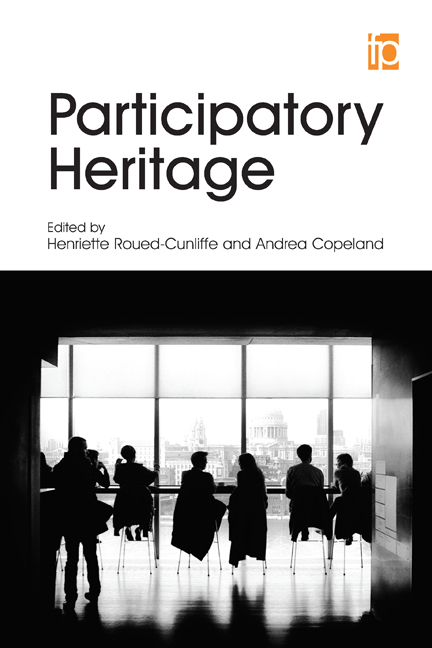Book contents
- Frontmatter
- Contents
- List of figures and tables
- Contributors
- Introduction: what is participatory heritage?
- Part 1 Participants
- Part 2 Challenges
- Part 3 Solutions
- 14 Ethiopian stories in an English landscape
- 15 Having a lovely time: localized crowdsourcing to create a 1930s street view of Bristol from a digitized postcard collection
- 16 Digital archiving in Canadian artist-run centres
- 17 New approaches to the community recording and preservation of burial space
- 18 A case for collaboration: solving practical problems in cultural heritage digitization projects
- 19 Open heritage data and APIs
- Further reading
- Index
16 - Digital archiving in Canadian artist-run centres
from Part 3 - Solutions
Published online by Cambridge University Press: 08 June 2018
- Frontmatter
- Contents
- List of figures and tables
- Contributors
- Introduction: what is participatory heritage?
- Part 1 Participants
- Part 2 Challenges
- Part 3 Solutions
- 14 Ethiopian stories in an English landscape
- 15 Having a lovely time: localized crowdsourcing to create a 1930s street view of Bristol from a digitized postcard collection
- 16 Digital archiving in Canadian artist-run centres
- 17 New approaches to the community recording and preservation of burial space
- 18 A case for collaboration: solving practical problems in cultural heritage digitization projects
- 19 Open heritage data and APIs
- Further reading
- Index
Summary
RESEARCHERS OFTEN BENEFIT from looking beyond traditional library and archival collections to engage with communities that cultivate the information they seek. For people looking for information about contemporary art and artists in Canada, artist-run centres (ARCs) are a rich but often overlooked resource. ARCs support the production and exhibition of new and experimental work and have become critical resources for artists, curators, researchers and the public. Today, many of these non-profit organizations have been active for over three decades and have accumulated significant collections covering their operations, art and artists they have supported and community history. These collections are unique, consisting of ephemera, independent publications and documentation rarely captured outside of these centres. ARC leaders have long anticipated an audience for their archives but have struggled to find a logical solution to preserve and provide access to their collections. This chapter discusses the value of these collections and the challenges that ARCs, lacking an archival mandate, encounter in preserving and making their collections accessible. Based on interviews with the directors of nine ARCs in Saskatchewan and Alberta, I offer three potential solutions that fit the organizational culture and mandate of these non-profit, independent arts organizations: web archiving; independent archives; and post-custodial partnerships.
Artist-run centres
The role of ARCs is to encourage the creation and exhibition of new and experimental art by providing gallery space, production assistance and community support to artists. The development of ARCs began in the early 1970s with funding from the Canada Council for the Arts. Originally intended as a network of centres spread across the country, each of the approximately 170 ARCs (Artist-Run Centres and Collectives Conference, 2015) is largely autonomous, with distinct mandates that make this a diverse community to study. However, ARCs share some features; they support contemporary art, operate on a non-profit model and take an artist-centred approach that values self-determinism for artists and themselves. These qualities set ARCs apart from museums and commercial galleries. ARCS are not unique to Canada. Similar collectives exist in other countries, but the network of Canadian ARCs is particularly well established and vital.
As venues for emerging artists and curators, and producers of curatorial writing, criticism and policy, ARCs are crucially important to their communities. Most Canadian contemporary artists, curators and cultural practitioners, including the country's most recognized talents, have emerged from the ARC system (Artist-run Centres and Collectives Conference, 2009).
- Type
- Chapter
- Information
- Participatory Heritage , pp. 163 - 172Publisher: FacetPrint publication year: 2017



